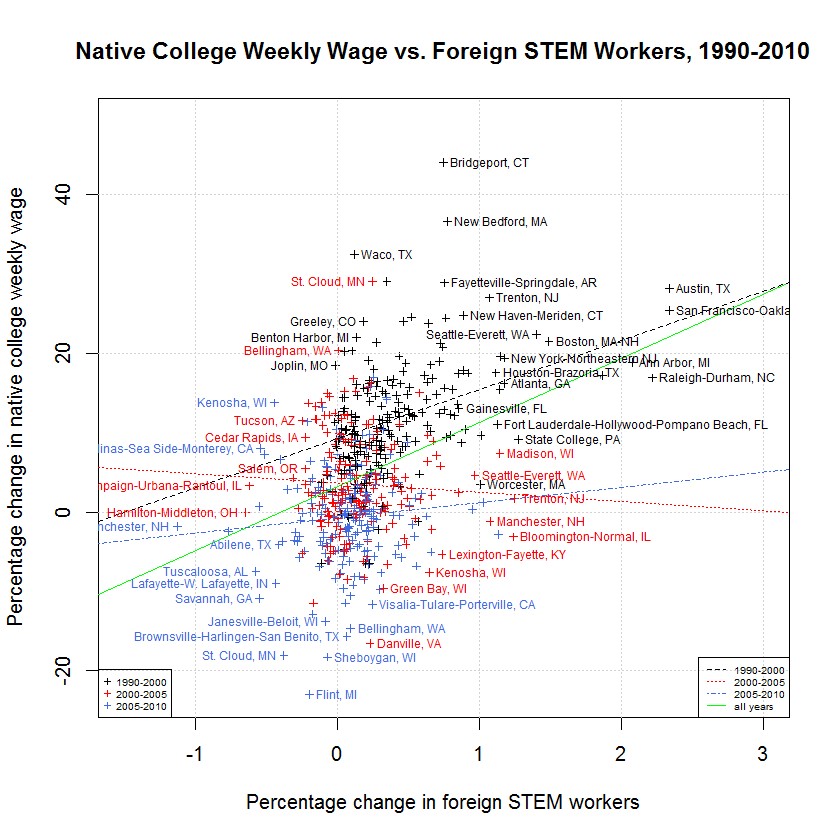
1. Success in Replicating Tables 1 to 3 of the Study
As can be seen below, I was generally accurate in replicating the data from 2000 to 2010 but ran into some problems with 1980 to 1990. 1990 to 2000 had mixed results with a fair amount of accuracy in Table 1 but less in Tables 2 and 3. I used the same sources as the study and followed the data filtering as carefully as possible so I don't know what the problem is with the earlier data.
[1] " Table 1: Summary Statistics, Percentage of Foreign-Born by Group " [1] "---- ------------------------- ------------------------- -------------------------" [1] " % Among College % Employment in % Among College Educated " [1] " Educated Employment STEM Occupations Empl. in STEM Occupations" [1] "---- ------------------------- ------------------------- -------------------------" [1] "Year Study Calc % Diff Study Calc % Diff Study Calc % Diff" [1] "---- ------- ------- ------- ------- ------- ------- ------- ------- -------" [1] "1980 8.01 9.59 19.66 9.27 9.28 0.16 12.18 16.81 38.04" [1] "1990 10.51 10.53 0.19 12.63 12.48 -1.20 15.64 15.17 -3.02" [1] "2000 14.75 14.75 0.01 19.66 19.58 -0.41 24.74 24.80 0.24" [1] "2005 17.10 17.09 -0.05 22.74 22.91 0.76 28.40 28.66 0.91" [1] "2010 17.74 17.76 0.13 23.95 23.91 -0.16 29.74 29.80 0.21" [1] "" [1] "Table 2: College Educated STEM Workers as % of Employment (219 Metro Areas)" [1] "----------------------------------------------------------" [1] " Foreign STEM Total STEM " [1] "---- ------------------------- -------------------------" [1] "Year Study Calc % Diff Study Calc % Diff" [1] "---- ------- ------- ------- ------- ------- -------" [1] "1980 0.26 0.15 -41.32 2.11 0.88 -58.09" [1] "1990 0.45 0.40 -11.48 2.90 2.59 -10.64" [1] "2000 0.87 0.86 -0.64 3.52 3.48 -1.25" [1] "2005 1.00 1.02 2.43 3.52 3.52 -0.12" [1] "2010 1.10 1.09 -0.51 3.71 3.66 -1.28" [1] "" [1] "Table 3: Net Increase in College Educated STEM Workers (thousands)" [1] "--------- ------------------------- -------------------------" [1] " Change in Total Change in Foreign " [1] " College Educated STEM College Educated STEM " [1] "--------- ------------------------- -------------------------" [1] "Year Span Study Calc % Diff Study Calc % Diff" [1] "--------- ------- ------- ------- ------- ------- -------" [1] "1980-1990 980 1594 62.63 204 229 12.04" [1] "1990-2000 1114 1345 20.78 498 547 9.83" [1] "2000-2005 254 247 -2.88 202 202 -0.17" [1] "2005-2010 269 274 1.72 131 131 -0.15" [1] ""
As can be seen below, the slopes of the regressions were generally within a power of two except for the last one. This is not too surprising as the study gave fewer specifics about some of the filtering, I used OLS instead of 2SLS regression, and didn't attempt to use H-1B Inputed Growth of Foreign-STEM as an explanatory variable.
[1] " CORREL " [1] " N INTERCEPT SLOPE STUDY COEF P-VALUE DESCRIPTION " [1] "-- --------- -------- ------- ------- ------- -----------------------------------" [1] "1990-2010, WEIGHTED WITH DUMMY VARIABLES" [1] " 1) 1.7771 2.9172 6.6500 0.1951 1.0e-05 natstem_wkwage_chg ~ immig_stem_change + fspan + fmets" [1] " 2) 6.9861 3.8844 8.0300 0.4449 1.7e-31 natcoll_wkwage_chg ~ immig_stem_change + fspan + fmets" [1] " 3) 9.7421 1.9323 3.7800 0.3526 1.8e-25 natncol_wkwage_chg ~ immig_stem_change + fspan + fmets" [1] " 4) 3.2045 8.0875 8.0300 0.4449 2.9e-30 natcoll_wkwage_chg ~ immig_stem_change, 1990-2010" [1] " 5) 9.2601 6.2094 0.5148 4.6e-15 natcoll_wkwage_chg ~ immig_stem_change, 1990-2000" [1] " 6) 3.6916 -1.1559 -0.0530 4.6e-01 natcoll_wkwage_chg ~ immig_stem_change, 2000-2005" [1] " 7) -0.7571 1.9272 0.0880 2.2e-01 natcoll_wkwage_chg ~ immig_stem_change, 2005-2010" [1] " 8) 1.4166 0.7958 0.5300 0.4351 2.7e-37 native_stem_change ~ immig_stem_change + fspan + fmets" [1] " 9) 5.3894 3.9624 2.4700 0.4392 3.0e-32 native_coll_change ~ immig_stem_change + fspan + fmets" [1] "10) 9.8542 0.4187 -5.1700 0.1627 1.0e-05 native_ncol_change ~ immig_stem_change + fspan + fmets"
The following plot shows the relationship between the percentage change in the weekly wage of native college educated workers and the percentage change in the number of foreign STEM workers.

As can be seen, there was a relatively strong correlation while wages were increasing strongly during 1990 to 2000. However, wages appear to have generally stagnated in 2000 to 2005 and shrank in many areas in 2005-2010. In 2000-2005, there was a slightly negative correlation and in 2005-2010, there was a slightly positive correlation. This may represent an example of Simpson's Paradox in that the regression slope of each of the 3 time spans is less than the regression slope of the entire time period.